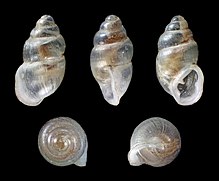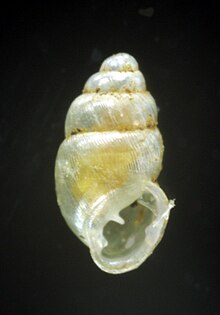Carychium minimum
Bulbous dwarf horn snail ( Carychium minimum)
The Dwarf Bulbous horn snail ( Carychium minimum), also Bellied dwarf worm is a very small snail from the family of dwarf horn snails ( Carychiidae ) in the order of snails ( Pulmonata ).
- 5.1 Literature
- 5.2 Notes and references
- 5.3 online
Features
The spindle-shaped housing is 1.6 to 2.2 mm high and 0.9 to 1.1 mm wide. The 4 ½, only weakly convex whorls increase rapidly and provide the housing with a bulbous shape, ie it is comparatively wide. The mouth is oblique to the axis of coiling. The aperture rim is slightly turned outward and inward thickened by a lip. From the outer lip projects a lower but wider tooth into the mouth. On the inner lip a spindle and a Parietallamelle is constructed, of which the latter extends deep into the case. In the fresh case it is, lying on the left side spindle, through the shell visible. The blade has a simple, s -shaped profile. The housing is colorless and almost transparent in the living animal, the surface shiny. No more fresh cases are milky white with a matt surface.
The body of the animal is whitish, the organs show through. The highly visible as dark spots eyes sitting at the base of the cone shaped probe. The second (lower) sensor pair is, however, formed only rudimentary.
Similar Species
The case of the dwarf bulbous horn snail is not as slim as the case of lean dwarf horn snail ( Carychium tridentatum ); the Höhen-/Breiten-Index is less than 2 (for the lean dwarf whelk > 2).
Geographical distribution, habitat and behavior
The distribution area extends across Eurasia. However, in Europe it is missing in the southern parts of the Mediterranean region. In Northern Europe, the range extends beyond 60 ° latitude. There, however, it is very rare and limited to the coastal areas. The Dwarf Bulbous horn worm is also known from Turkey, but so far only from a single locality (Konya ). She was abducted by human to North America.
The species prefers wet habitats such as swamps inhabited permanently, wet meadows, moist river valleys and valley meadows, floodplain forests and riparian areas of ( still ) waters from the lower level to mountainous areas, in Switzerland to 1800 m. She lives under stones, plants, and submerged objects such as logs and branches as well as in damp leaves and rotting, moist wood.
She does not tolerate drying out of their habitats and is therefore sensitive to declining groundwater levels and drainage. The other hand, you survived even longer lasting floods their habitats.
The Dwarf Bulbous horn worm is three to four generations per year.
Endangering
The Dwarf Bulbous horn snail is not at risk in Germany, but the stocks are declining in Bavaria. She stands there on the early warning list. In Britain and Ireland the type shows no decline of stock and is tolerant of human interference in their habitat, if dehydration is avoided.
Taxonomy
The species was erected in 1774 by Otto Friedrich. It is the type species of the genus Carychium Müller, 1773, which was a year earlier set up. 2012 was the kind Carychium mariae Paulucci, recognized in 1878 as a junior synonym of dwarf horn snail. Some authors distinguish two subgenera within the genus Carychium that Nominatuntergattung Carychium ( Carychium ) and Carychium ( Saraphia ) Risso, 1926. During this further subdivision of C. minimum is provided Nominatuntergattung.





/slides/Carychiidae%252520Carychium%252520minimum%252520(3575)%252520Germany%252520F%252B%2525201%252520mm.jpg)



